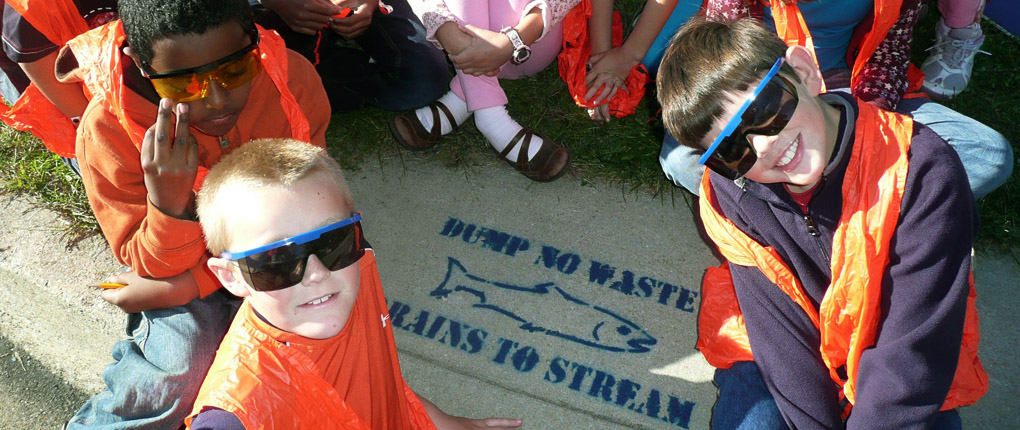Improve Local Streams
What is a watershed and how does it affect my local streams?
A watershed is an area of land that drains into a common body of water. Everyone lives in a watershed! In urban areas, most water that is on the ground, whether it is from a hose or from the sky, enters into storm drains. These storm drains empty into storm sewer systems which go directly to streams, rivers, and lakes NOT to treatment plants. This means that everything that is on the ground ends up in our streams. Therefore we must be extremely vigilant to minimize pollutants that end up on the ground, like fertilizers, animal waste, trash, and vehicle fluid.
Runoff in Urban versus Rural Areas
There is much more runoff in urban areas due to a greater amount of impervious surfaces. An impervious surface is one that water cannot penetrate, like roads, sidewalks, or buildings. When water doesn’t absorb into the ground, it and all the pollutants it has picked up from the ground are carried into storm drains and straight to a body of water. Alternatively, when water hits a pervious surface, like grass, dirt, or mulch, much of it absorbs into the ground. During this absorbance, most of the pollutants are filtered out and the water re-enters the groundwater supply.
Besides polluting our waterways, excess runoff generated by urban areas causes issues like flooding, erosion of stream banks, and depletion of the groundwater supply. The biggest way to combat this is to minimize impervious surfaces. Concrete paths can be replaced with mulch, roads can be made of permeable pavement, and parking lots can be replaced with gravel or permeable pavement. Rain barrels are a great way to catch water that is filtering off the impervious surfaces of your home. Not only does this decrease runoff, but it also conserves water when you reuse it for tasks like watering plants. Green roofs are an excellent option for city buildings. They absorb rainwater and improve air quality. Rain gardens are wonderful for catching runoff and filtering out pollutants. And riparian buffers are super important for preventing pollutants from filtering right down stream banks.
What can you do to improve water quality in Kentucky?
Participate in a local litter clean-up
Removing litter from streams and roadways is an easy activity for all ages that helps to create a cleaner Kentucky for everyone! Litter and illegal dumping pose a major threat to water quality in the Bluegrass. Check out our events page for upcoming community litter clean-ups, or for click here for instructions on how to organize your own litter clean-up.

Use and dispose of harmful materials properly
Don’t dump them on the ground! Hazardous waste that is dumped on or buried in the ground can contaminate the soil and can move down into the ground water or be carried into nearby surface waters by runoff during rainstorms. You might be surprised to learn that a number of products you use at home contain hazardous or toxic substances. Products like motor oil, pesticides, leftover paints or paint cans, mothballs, flea collars, weed killers, household cleaners and even a number of medicines contain materials that can be harmful to surface water and ground water. Make sure to always dispose of these materials properly. If you are unsure of how to dispose a specific material, please call 311 in Lexington or Bluegrass Greensource (859) 266-1572.
Organize a storm drain stenciling project
Many people don’t know that storm drains lead directly to our waterways. Everything that enters a storm drain or storm inlet is washed into nearby streams, lakes, and rivers without going through a treatment plant. Only rainwater should go down the drain!
Stenciling storm drains educates citizens so that everyone knows that pollutants don’t belong in storm drains. Organizing a storm drain stenciling project is a great volunteer opportunity. Contact Bluegrass Greensource to schedule your next storm drain stenciling project. Click here for more information on storm drain stenciling.

Don’t overuse pesticides, herbicides, and/or fertilizers
Many people apply fertilizers, herbicides, and/or pesticides to make lawns thick and green, flowers colorful, and vegetable crops weed-free and abundant. Many pesticides are used to keep bugs from ruining what the fertilizers have helped to produce. However, many people do not realize that many of these fertilizers, herbicides and pesticides contain hazardous chemicals that can travel through storm water and/or the soil and contaminate both drinking water and ground water.
Take some time and consider whether you really need these chemicals to get the desired result in your lawn. If these chemicals are used at all, they should be used in moderation. For more information about responsible lawn care click here.
Invite Bluegrass Greensource to your school, business, or community organization
Bluegrass Greensource can provide water quality and conservation education to your school, business, or community organization. To find out what educational opportunities are available in your community, please contact Bluegrass Greensource at info@bggreensource.org or call (859) 266-1572.